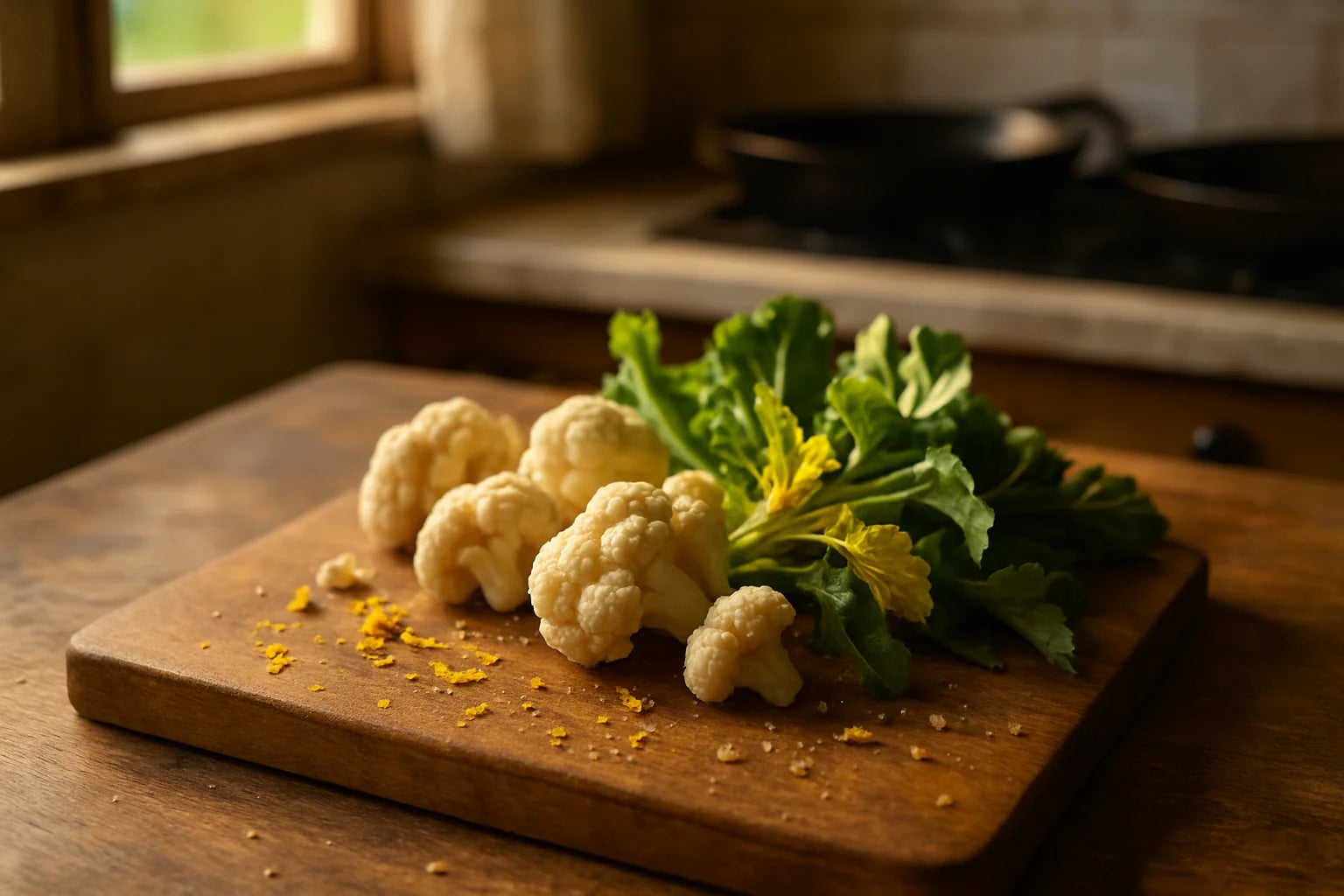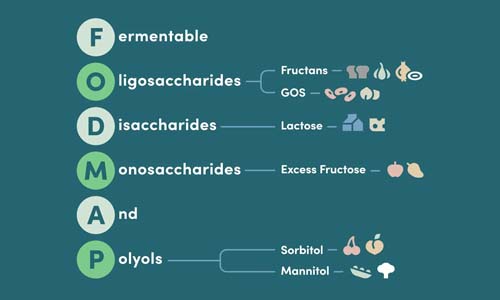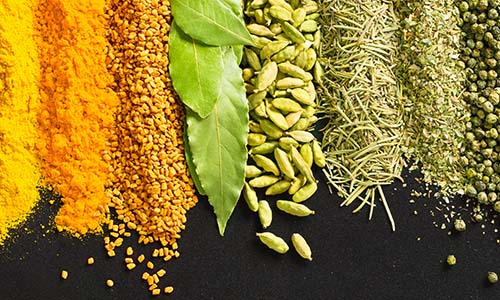Is Cauliflower Low FODMAP? Latest Research + Tips

Key Takeaways
- Recent research shows that cauliflower is low FODMAP when consumed in specific serving sizes.
- Cauliflower was previously thought to be problematic for IBS sufferers but is now considered more gut-friendly.
- This new understanding allows for more diverse and flavorful vegetable options for those managing IBS.
- Proper portion control is key to enjoying cauliflower without triggering FODMAP-related symptoms.
Table of Contents
- What Does "Low FODMAP" Mean? Key Facts for IBS-Friendly Eating
- Cauliflower's FODMAP Journey: From Off-Limits to On the Menu
- Smart Ways to Enjoy Cauliflower on a Low FODMAP Diet
- How Cauliflower Compares to Other Popular Vegetables
- Safe, Flavorful Cauliflower Recipes & Serving Ideas
- Troubleshooting: When Cauliflower Still Causes Symptoms
- Best Resources & Apps for Navigating Low FODMAP Choices
- Final Thoughts: Abundance, Not Restriction, in Your Low FODMAP Kitchen
- Frequently Asked Cauliflower & Low FODMAP Questions
- Expert Verdict: Your Cauliflower Success Strategy
- Looking Ahead: The Future of Low FODMAP Research
Is Cauliflower Low FODMAP? Latest Research, Practical Cooking Tips, and IBS Solutions
The answer to "is cauliflower low fodmap" has evolved dramatically. Recent testing reveals that cauliflower, once considered problematic for IBS sufferers, now earns low FODMAP status at specific serving sizes. This shift opens exciting culinary possibilities for anyone seeking gut-friendly vegetables without sacrificing flavor.
For those looking to add more variety to their low FODMAP meals, Gourmend's Low FODMAP Organic Vegetable Broth is a flavorful foundation that pairs perfectly with cauliflower and other IBS-friendly vegetables.
If you want to explore more ways to enjoy cauliflower and other low FODMAP vegetables, try incorporating them into comforting dishes like simple low FODMAP gourmet risotto for a satisfying, gut-friendly meal.
What Does "Low FODMAP" Mean? Key Facts for IBS-Friendly Eating
FODMAPs are fermentable carbohydrates that can trigger digestive symptoms like bloating, gas, and abdominal pain in sensitive individuals. The acronym stands for Fermentable Oligosaccharides, Disaccharides, Monosaccharides, and Polyols, but you don't need to memorize that to benefit from this approach.
| FODMAP Type | Common Food Sources | Why It Matters |
|---|---|---|
| Fructans | Wheat, certain vegetables | Most relevant for cauliflower |
| Fructose | Honey, some fruits | Portion-dependent triggers |
| Galactans | Legumes, beans | Gas-producing compounds |
| Lactose | Dairy products | Enzyme deficiency issues |
| Polyols | Stone fruits, sugar alcohols | Osmotic effect in gut |
The low FODMAP approach focuses on abundance rather than restriction, discovering which foods support easier digestion while maintaining bold, satisfying flavors.
Cauliflower's FODMAP Journey: From Off-Limits to On the Menu

Cauliflower's FODMAP status represents one of nutrition science's most significant reversals. Earlier research labeled it high FODMAP due to fructan content, leading many IBS sufferers to avoid it entirely. However, refined testing methods and updated agricultural data tell a different story.
The 2025 Monash University update reclassified both white and purple cauliflower as low FODMAP at ¾ cup servings. This change reflects improved testing accuracy and recognition that FODMAP levels vary significantly based on growing conditions, storage methods, and preparation techniques.
Why portion control still matters: Fructan concentration increases substantially in larger servings. Beyond ¾ cup, cauliflower fodmap levels climb into moderate territory, potentially triggering symptoms in sensitive individuals. This threshold isn't arbitrary, it's based on rigorous laboratory analysis of how these compounds behave in our digestive systems.
Smart Ways to Enjoy Cauliflower on a Low FODMAP Diet
Success with low fodmap cauliflower starts with precision. Measure that ¾ cup serving carefully, it's roughly the size of your cupped palm. Begin with smaller portions if you're particularly sensitive, gradually increasing as your tolerance allows.
Cooking techniques that maximize digestibility:
- Steam for 8-10 minutes until fork-tender to break down tough fibers
- Roast at 425°F with olive oil and chive sprigs for caramelized sweetness
- Pulse into "rice" and sauté with Gourmend Vegetable Broth for umami depth
Our Gourmend broths use chives, scallion greens, and leek tops instead of high-FODMAP aromatics, delivering restaurant-quality flavor while supporting digestive comfort. The Vegetable Broth includes nori seaweed and oyster mushrooms for additional umami complexity that transforms simple cauliflower into gourmet territory.
How Cauliflower Compares to Other Popular Vegetables
Understanding where cauliflower fits among other vegetables helps you make strategic swaps and combinations. Each vegetable offers unique benefits for those managing IBS symptoms.
Cauliflower's ¾ cup limit makes it more restrictive than potatoes (virtually FODMAP-free) but more generous than Brussels sprouts (¼ cup maximum). When choosing between cauliflower low fodmap options and alternatives, consider your meal's overall FODMAP load and flavor goals.
For stir-fries and grain bowls, cauliflower rice provides excellent texture without the wheat-based fructans found in regular grains. Its neutral flavor profile accepts bold seasonings beautifully, making it particularly valuable for international cuisines where traditional aromatics might be problematic.
Safe, Flavorful Cauliflower Recipes & Serving Ideas

Transform your ¾ cup cauliflower serving into restaurant-quality dishes with these tested techniques. Each recipe maximizes flavor while respecting low FODMAP boundaries.
Cauliflower "Rice" with Chive Oil: Pulse cauliflower florets until rice-sized. Sauté in olive oil with fresh chive sprigs and a splash of Gourmend Vegetable Broth for 5 minutes. The nori and oyster mushrooms in our broth add umami depth without high-FODMAP aromatics.
Creamy Mashed Cauliflower: Steam cauliflower until tender, then mash with lactose-free butter and scallion greens. The result rivals traditional mashed potatoes with better digestibility.
Roasted Cauliflower with Cumin: Toss florets with olive oil, ground cumin, and lemon zest. Roast at 425°F for 20 minutes until golden. This technique caramelizes natural sugars while maintaining the low FODMAP profile.
If you're looking for a delicious side dish to pair with your cauliflower, try these low FODMAP crisp roasted baby potatoes for a satisfying and gut-friendly addition to your meal.
Troubleshooting: When Cauliflower Still Causes Symptoms
Even at low FODMAP servings, some individuals experience digestive discomfort from cauliflower's natural sulfur compounds and fiber content. This doesn't necessarily indicate FODMAP intolerance, it may reflect individual sensitivity to these other components.
Symptom Management Strategies
| Symptom | Likely Cause | What to Try |
|---|---|---|
| Gas/bloating after ¾ cup | Sulfur compounds or fiber sensitivity | Reduce to ¼ cup, cook thoroughly |
| Symptoms with any amount | Individual intolerance | Pause use, try again in 2-3 weeks |
| Digestive upset hours later | Possible FODMAP stacking | Review other foods consumed |
If symptoms persist despite proper portions, combine cauliflower with soothing foods like white rice or carrots. Cooking in Gourmend broth can also ease digestion while adding satisfying flavor complexity.
For another main course idea that fits a low FODMAP lifestyle, consider this low FODMAP braised short ribs recipe for a hearty, IBS-friendly meal.
Remember: the low FODMAP diet is a diagnostic tool, not a permanent restriction. Work with a qualified dietitian to identify your specific triggers and develop a sustainable eating pattern that includes as many foods as possible.
Best Resources & Apps for Navigating Low FODMAP Choices
Reliable information makes the difference between dietary success and confusion. The Monash University FODMAP Diet app remains the gold standard, providing laboratory-tested data updated as new research emerges, including the recent cauliflower reclassification.
Many online resources still list cauliflower as high FODMAP, reflecting outdated information. This highlights why official, research-backed sources matter for accurate guidance. Generic food blogs and older publications may not reflect current scientific understanding. For a comprehensive overview of FODMAPs and digestive health, see this NHS guide to food intolerance and FODMAPs.
Gourmend Foods supports your low FODMAP journey with evidence-based recipes and ingredient transparency. Our broths eliminate guesswork by using only tested, compliant ingredients while delivering the complex flavors that make restrictive eating feel abundant rather than limiting.
Professional guidance from a registered dietitian trained in FODMAP protocols can personalize your approach, helping you reintroduce foods systematically and build a sustainable long-term eating pattern.
Final Thoughts: Abundance, Not Restriction, in Your Low FODMAP Kitchen

The evolution of cauliflower from forbidden to friendly exemplifies how the low FODMAP approach continues advancing toward greater food freedom. When you ask "is cauliflower low fodmap," you're not just seeking permission to eat a vegetable, you're embracing a philosophy that prioritizes both digestive comfort and culinary joy.
At Gourmend Foods, we believe managing IBS shouldn't mean sacrificing flavor or creativity. Our carefully crafted broths and seasonings, combined with evidence-based guidance, transform restriction into exploration. Every meal becomes an opportunity to discover new combinations that nourish both body and palate.
Your low FODMAP kitchen can be a place of abundance, experimentation, and satisfaction. Start with that perfectly portioned ¾ cup of cauliflower, and let your culinary confidence grow from there.
Frequently Asked Cauliflower & Low FODMAP Questions
Expert Verdict: Your Cauliflower Success Strategy
The question "is cauliflower low fodmap" now has a definitive answer: yes, at ¾ cup servings for both white and purple varieties. This represents a significant win for anyone managing IBS while seeking dietary variety and nutritional density.
Success with cauliflower requires precision in portioning and attention to individual tolerance. Start conservatively, cook thoroughly, and pair with proven flavor enhancers like Gourmend's shelf-stable broth cartons, which provide the onion-garlic depth you're missing without FODMAP complications.
The broader lesson extends beyond cauliflower: the low FODMAP landscape continues evolving as research advances. Foods once considered off-limits may return to your plate, while others may require new caution. This dynamic nature makes reliable resources and quality ingredients more valuable than ever.
Looking Ahead: The Future of Low FODMAP Research

Cauliflower's reclassification signals broader shifts in FODMAP science. Researchers are refining testing methodologies, examining how processing affects FODMAP content, and investigating individual genetic variations that influence tolerance levels.
Emerging studies suggest that gut microbiome diversity may affect FODMAP sensitivity, potentially leading to more personalized dietary approaches. This could mean that your cauliflower tolerance, and that of other borderline foods, may improve with targeted gut health support.
For now, the evidence supports cautious optimism. That ¾ cup of perfectly seasoned cauliflower represents more than a serving size, it's proof that restriction-based diets can evolve toward abundance when guided by rigorous science and quality ingredients.
Whether you're preparing cauliflower rice with chive sprigs or roasting florets with cumin and lemon zest, remember that managing IBS doesn't require sacrificing culinary satisfaction. The right approach combines current research, individual awareness, and ingredients designed to maximize both flavor and digestive comfort.
Frequently Asked Questions
What serving size of cauliflower is considered low FODMAP and safe for people with IBS?
Cauliflower is considered low FODMAP and safe for IBS when consumed in servings of about 1/2 cup (around 46 grams) cooked. Staying within this portion helps avoid triggering common FODMAP-related digestive symptoms.
Why was cauliflower previously classified as high FODMAP and what changed in recent research?
Cauliflower was once labeled high FODMAP due to its fructan content, which can ferment in the gut and cause discomfort. Recent research has shown that smaller, controlled servings contain fructans below symptom-triggering levels, allowing it to be reclassified as low FODMAP in those amounts.
How can I incorporate cauliflower into a low FODMAP diet without triggering digestive symptoms?
To enjoy cauliflower without symptoms, focus on portion control by limiting servings to about 1/2 cup cooked. Pair it with low FODMAP ingredients and use flavor boosters like Gourmend’s low FODMAP broths and seasonings to create satisfying, gut-friendly meals.
How does cauliflower's FODMAP content compare to other common vegetables on a low FODMAP diet?
Cauliflower contains moderate fructans but is lower in FODMAPs at controlled servings compared to high-fructan vegetables like onions or garlic. It offers more variety than some strict low FODMAP vegetables, making it a flavorful, gut-friendly option when portioned carefully.





